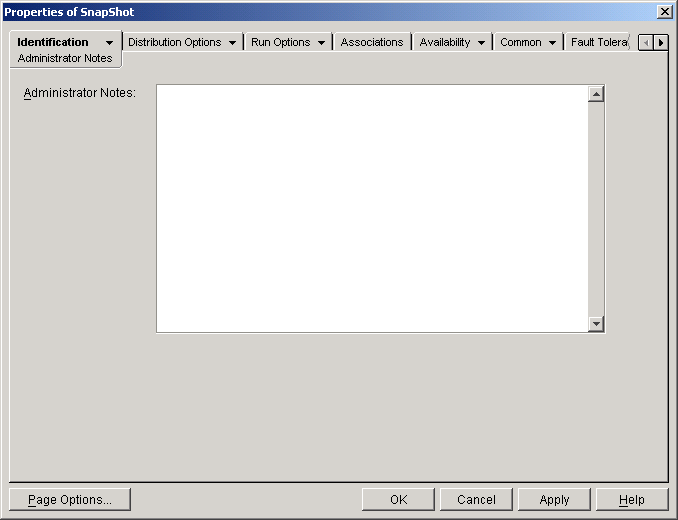48.1 Identification Tab
The Identification tab includes the following pages to help you configure how the Application object is displayed to users:
48.1.1 Package Information Page
The Package Information property page is available on Application objects created for MSI applications only. It is not available on Application objects created for simple applications, AOT/AXT applications, Web applications, and terminal server applications.
The Package Information property page, shown below, displays information about the Microsoft Windows Installer package file (.msi file) associated with the application. This page is for informational purposes only; you cannot use this page to modify the package’s information.
Figure 48-1 ApplicatioN Object > Identification Tab > Package Information Page
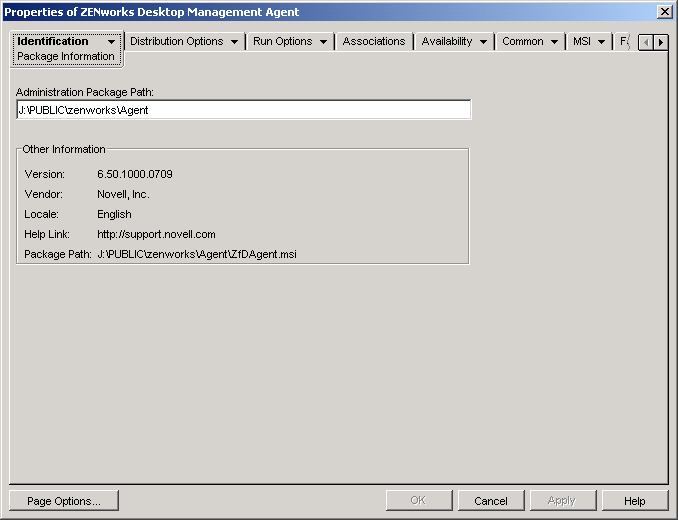
Package path
Displays the location of the .msi file being used by the Application object.
Version
Displays the version of the .msi file.
Vendor
Displays the creator of the .msi file.
Locale
Displays the locale defined in the .msi file.
Help Link
Displays the Web location to visit for information and help about the application.
48.1.2 Icon Page
The Icon property page is available on Application objects created for all application types (simple, AOT/AXT, MSI, Web, and terminal server).
The Icon property page, shown below, determines the Application object’s icon that Novell® Application Launcher™ displays on a workstation. You can give the application icon a title, select the graphic to use for the icon, and give the icon a display order and force run priority. You can determine whether or not Application Launcher should continue to display the Application object on the workstation when the user has disconnected from Novell eDirectory™.
Figure 48-2 ApplicaTion Object > Identification Tab > Icon Page
Application Icon Title
Specify the text you want to use as the icon title for the Application object. The icon title must conform to standard Windows folder and filename conventions. If you use the following invalid Windows folder and filename characters, they are replaced on the user's desktop with an underscore (_):
\ / : * ? " < > |
Application Icon
Select the icon you want to appear wherever the Application object’s icon is displayed. If you do not specify an icon, a default Application object icon is used.
Disconnectable
Select this option to mark the application as being able to be run on a workstation that is disconnected from eDirectory.
The application must be installed or cached to the workstation before the user can run it in disconnected mode. You can force the application to be installed on the workstation by selecting the characteristic ( page). You can force the application to be cached to the workstation by selecting the characteristic ( page).
Wait on Force Run
This option applies only if the application and at least one other application are using the option ( page).
Select this option to force the application to wait until the application that started before it terminates. The application order is defined in the field. Reboots are queued until the final application has terminated.
Determine Force Run Order
This option dictates the order in which applications set as are started. Select this option to enable it, and then use the Order list to select the application’s position in the order.
You control the order in which the application is started by entering a numeric value in the box. A value of zero gives the application the highest priority. The maximum value is 9999999. For example, if you want this application to start after two other applications that have been given the order of 0 and 1, you would enter 2 in the box.
Application Launcher runs the application without waiting for the previously started application to terminate, unless the option is enabled.
For Application Launcher to enforce the run order for a group of applications, all of the applications must already be distributed or cached to the workstation; otherwise, if all applications have not yet been distributed or cached to the workstation, the run order is not enforced. For example, if the second application of three that you want to force run has not yet been distributed or cached to the workstation, the first application is started, the distribution process is started for the second application, and then the third application is started. Because of the uncertainty in time required to distribute the second application, the third application might be available before distribution and launching of the second application is completed.
Show Progress
This option displays a progress bar to users when an application is distributed to or removed from their workstations. Turn off this option if you are distributing only a small change, such as a registry modification. Turn on this option if you are distributing or removing a large application and want to give the user an idea of how long the process takes.
With this option turned off, if the workstation must be rebooted to complete the installation process and the Prompt for Reboot setting is enabled ( tab > page), the user is not prompted and the workstation automatically reboots. The same is true if the workstation must be rebooted to complete the uninstall process and the Prompt User Before Uninstall setting is enabled ( tab > page).
User Interface Level
This option appears only if the Application object uses a Microsoft Windows Installer (MSI) package. During distribution of an MSI Application object, Application Launcher launches Windows Installer to install the application. As a result, rather than showing the standard Application Launcher installation progress bar, Windows Installer uses the installation user interface established for the MSI package. You can use the following settings to determine the amount of user interface the Windows Installer displays during installation.
-
Default: Displays an appropriate user interface level (as chosen by Windows Installer).
-
Silent: Displays no user interface.
-
Progress: Displays simple progress information and error messages/prompts.
-
Reduced: Displays a full user interface with Wizard dialog boxes suppressed.
-
Full: Displays a full user interface (Wizard dialog boxes, progress information, error messages and prompts, and so forth).
Application Launcher passes the selected setting to Windows Installer as a startup parameter. For more information about these settings, see the Microsoft Windows Installer documentation.
48.1.3 Description Page
The Description property page is available on Application objects created for all application types (simple, AOT/AXT, MSI, Web, and terminal server).
The Description property page, shown below, provides users more complete information about the Application object than the application icon title allows.
Figure 48-3 Application Object > Identification Tab > Description Page
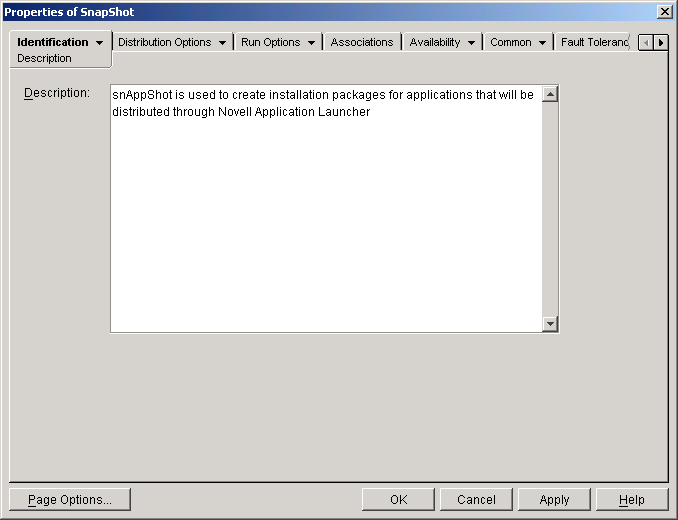
If you have enabled the Prompt User Before Distribution option ( > page), users see this description when Application Launcher first distributes the application to them. They can also view an Application object’s properties to see the description. To display the properties, right-click the Application object (on the workstation), then click .
48.1.4 Folders Page
The Folders property page is available on Application objects created for all application types (simple, AOT/AXT, MSI, Web, and terminal server).
The Folders property page, shown below, lets you specify the folders where you want Application Launcher to place the application when distributing it to a workstation.
Figure 48-4 Application Object > Identification Tab > Folders Page
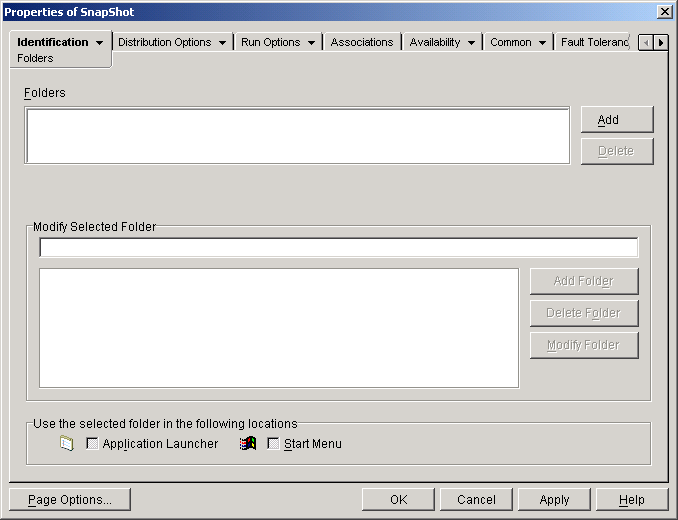
You can add the application to two different types of folders: a custom folder and a linked folder.
A custom folder is a folder created specifically for the Application object. No other Application objects can be included in the folder. Custom folders support folders within folders, which means that you can create a custom folder structure. For example, although you could not have Calculator and Notepad in the same custom folder, you could create two subfolders within the same custom folder and place the two programs in the two subfolders (in other words, winapps\calculator\calc.exe and winapps\notepad\notepad.exe).
A linked folder is simply an association to an existing Application Folder object. The Application Folder object must already exist in eDirectory. If the Application Folder object includes multiple folders (a folder structure) you can add the application to any folder in the structure.
If you plan to create a complex folder structure for the applications you distribute, we recommend that you use an Application Folder object and then link Application objects to the Application Folder object. An Application Folder object requires you to define the folder structure one time only, whereas custom folders must be defined for each Application object. If you choose to use custom folders for your folder structure, make sure you use the same folder names when defining the custom folder structure for each Application object. Any variation causes Application Launcher to create different custom folder structures.
Folders
The Folders list displays the custom folders and linked folders (Application Folder objects) that the application has been added to. Application Launcher creates (if necessary) the listed folders when distributing the application to the workstation.
Add
Click to add a custom folder or a linked folder to the Folders list. If you want the application to appear in multiple folders, add each folder to the list.
When you add a custom folder, it appears in the list with New Folder as its title. You can select the folder in the list and use the box to change the folder’s name or to add subfolders to it (see Modify Selected Folder below).
Delete
Select a folder in the folder list, then click to remove the folder from the list. The change is applied the next time Application Launcher restarts.
Modify Selected Folder
The Modify Selected Folder box lets you modify name and structure information for the folder that is selected in the Folders list. You can modify information for custom folders and linked folders. However, after you modify a linked folder’s information, it is converted to a custom folder.
Add Folder
Select the folder in the folder tree, then click to add a subfolder to the folder. After you add a subfolder and Application Launcher refreshes, users see the application in the subfolder rather than in the folder.
Delete Folder
Select the folder in the folder tree, then click to delete the folder. The change is applied the next time Application Launcher restarts.
Modify Folder
Select the folder in the folder tree, then click to change the name of the folder.
If you want to add the application to a new subfolder of an existing folder, enter existing_folder_name\new_subfolder_name.
Use the Selected Folder in the Following Locations
Application Launcher can display folders on the Windows Start menu and in the Application Launcher windows (Application Window and Application Explorer window), if these locations are enabled on the Application object’s Associations page. Select a folder in the Folders list, then select the check boxes for the locations where you want to use the folder.
If you don’t select either location, Application Launcher still displays the Application object on the Start menu and in the Application Launcher windows, but the object does not appear in the folders you’ve defined.
48.1.5 Contacts Page
The Contacts property page is available on Application objects created for all application types (simple, AOT/AXT, MSI, Web, and terminal server).
The Contacts property page, shown below, lists the names, e-mail addresses, and phone numbers of the application’s support staff. Users can access this information through the Application object’s properties. To display the properties, right-click the Application object (on the workstation), click , then click
Figure 48-5 Application Object > Identification Tab > Contacts Page
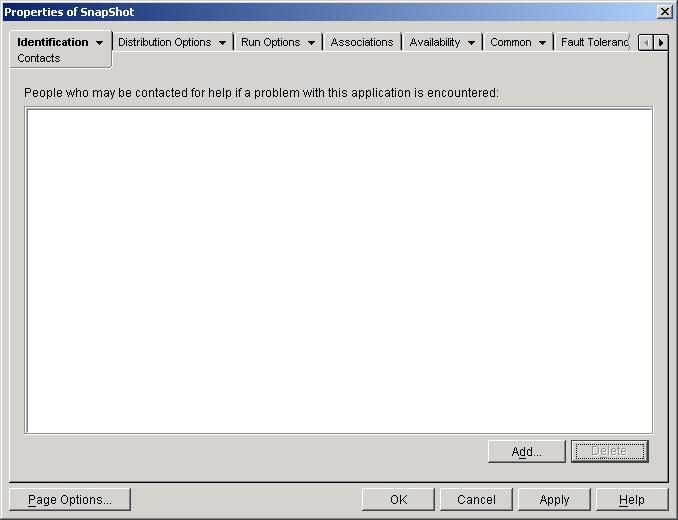
You can tailor the information to direct users to the support staff at their locations. If you enter the support contact’s e-mail address, users can send an e-mail message directly from the page of the Properties dialog box.
NOTE:Users must have the eDirectory rights required to read the field ( attribute) and field ( attribute) of the users defined as contacts.
48.1.6 Administrator Notes Page
The Administrator Notes property page is available on Application objects created for all application types (simple, AOT/AXT, MSI, Web, and terminal server).
The Administrator Notes property page, shown below, lets you record notes for yourself or other administrators. For example, you could remind yourself about special settings for an application. Or, if you have several administrators, you could write a history of upgrades and file changes.
Figure 48-6 Application Object > Identification Tab > Administrator Notes Page
